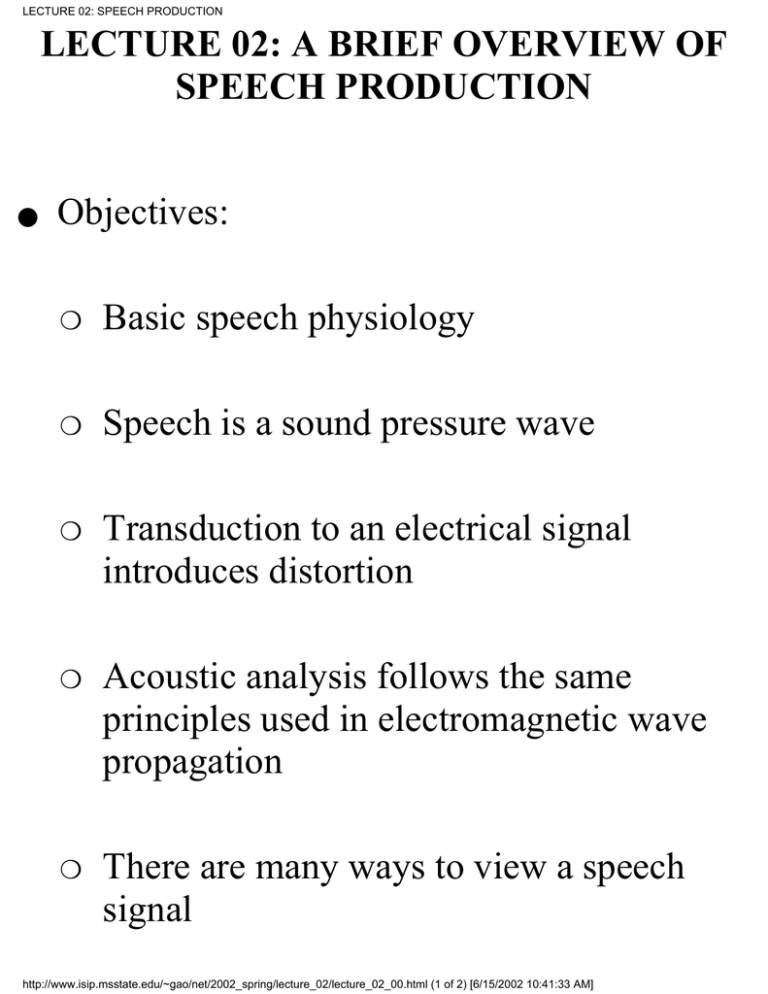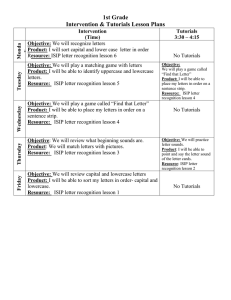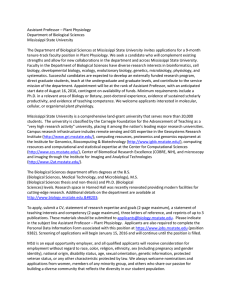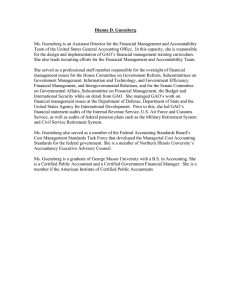lecture 03: sound propagation - Perception Signal Processing Lab
advertisement

LECTURE 02: SPEECH PRODUCTION LECTURE 02: A BRIEF OVERVIEW OF SPEECH PRODUCTION ● Objectives: ❍ Basic speech physiology ❍ Speech is a sound pressure wave ❍ Transduction to an electrical signal introduces distortion ❍ Acoustic analysis follows the same principles used in electromagnetic wave propagation ❍ There are many ways to view a speech signal http://www.isip.msstate.edu/~gao/net/2002_spring/lecture_02/lecture_02_00.html (1 of 2) [6/15/2002 10:41:33 AM] LECTURE 02: SPEECH PRODUCTION ❍ Concatenated tube models (linear acoustics) This lecture contains material from an excellent textbook on the fundamentals of speech processing: J. Deller, et. al., Discrete-Time Processing of Speech Signals, MacMillan Publishing Co., ISBN: 0-7803-5386-2, 2000. as well as information found in the course textbook: X. Huang, A. Acero, and H.W. Hon, Spoken Language Processing - A Guide to Theory, Algorithm, and System Development, Prentice Hall, Upper Saddle River, New Jersey, USA, ISBN: 0-13-022616-5, 2001. http://www.isip.msstate.edu/~gao/net/2002_spring/lecture_02/lecture_02_00.html (2 of 2) [6/15/2002 10:41:33 AM] LECTURE 02: SPEECH PRODUCTION SAGGITAL PLANE VIEW OF THE HUMAN VOCAL APPARATUS Glottis: 聲門 larynx:喉頭 Pharynx:咽頭 Velum:軟顎 Vocal chords:聲帶 Esophagus:食道 Diaphragm:橫隔膜 Trachea:氣管 http://www.isip.msstate.edu/~gao/net/2002_spring/lecture_02/lecture_02_01.html (1 of 2) [6/15/2002 10:41:34 AM] LECTURE 02: SPEECH PRODUCTION SAGGITAL X-RAY OF THE HUMAN VOCAL APPARATUS http://www.isip.msstate.edu/~gao/net/2002_spring/lecture_02/lecture_02_02.html (1 of 2) [6/15/2002 10:41:35 AM] LECTURE 02: SPEECH PRODUCTION VOCAL CORDS - SOURCE OF EXCITATION http://www.isip.msstate.edu/~gao/net/2002_spring/lecture_02/lecture_02_03.html [6/15/2002 10:41:35 AM] LECTURE 02: SPEECH PRODUCTION TRANSDUCTION ● Speech is a sound pressure wave that must be converted to an electrical signal, and then a digital signal, to be processed. This conversion process introduces distortion (frequency response, nonlinear dynamics, etc.). http://www.isip.msstate.edu/~gao/net/2002_spring/lecture_02/lecture_02_04.html (1 of 2) [6/15/2002 10:41:35 AM] LECTURE 02: SPEECH PRODUCTION http://www.isip.msstate.edu/~gao/net/2002_spring/lecture_02/lecture_02_04.html (2 of 2) [6/15/2002 10:41:35 AM] LECTURE 02: SPEECH PRODUCTION WHAT DOES A SPEECH SIGNAL LOOK LIKE? http://www.isip.msstate.edu/~gao/net/2002_spring/lecture_02/lecture_02_05.html (1 of 4) [6/15/2002 10:41:37 AM] LECTURE 02: SPEECH PRODUCTION ● We often prefer to view a spectrogram using a color visualization in which spectral log magnitude is mapped to "temperature" (the color that emanates from a steel bar when it is heated): ● Here are more examples of color spectrograms using the ever-popular Texas Instruments color map: http://www.isip.msstate.edu/~gao/net/2002_spring/lecture_02/lecture_02_05.html (2 of 4) [6/15/2002 10:41:37 AM] LECTURE 02: SPEECH PRODUCTION http://www.isip.msstate.edu/~gao/net/2002_spring/lecture_02/lecture_02_05.html (3 of 4) [6/15/2002 10:41:37 AM] LECTURE 02: SPEECH PRODUCTION http://www.isip.msstate.edu/~gao/net/2002_spring/lecture_02/lecture_02_05.html (4 of 4) [6/15/2002 10:41:37 AM] LECTURE 02: SPEECH PRODUCTION SOUND PROPAGATION - LINEAR ACOUSTICS A detailed acoustic theory must consider the effects of the following: ● Time variation of the vocal tract shape http://www.isip.msstate.edu/~gao/net/2002_spring/lecture_02/lecture_02_06.html (1 of 4) [6/15/2002 10:41:38 AM] LECTURE 02: SPEECH PRODUCTION ● Losses due to heat conduction and viscous friction at the vocal tract walls ● Softness of the vocal tract walls ● Radiation http://www.isip.msstate.edu/~gao/net/2002_spring/lecture_02/lecture_02_06.html (2 of 4) [6/15/2002 10:41:38 AM] LECTURE 02: SPEECH PRODUCTION of sound at the lips ● Nasal coupling ● Excitation of sound in the vocal tract ● Let us consider a simple case of a lossless tube: http://www.isip.msstate.edu/~gao/net/2002_spring/lecture_02/lecture_02_06.html (3 of 4) [6/15/2002 10:41:38 AM] LECTURE 02: SPEECH PRODUCTION http://www.isip.msstate.edu/~gao/net/2002_spring/lecture_02/lecture_02_06.html (4 of 4) [6/15/2002 10:41:38 AM] LECTURE 02: SPEECH PRODUCTION WAVE PROPAGATION http://www.isip.msstate.edu/~gao/net/2002_spring/lecture_02/lecture_02_07.html [6/15/2002 10:41:38 AM] LECTURE 02: SPEECH PRODUCTION HELIUM SPEECH: RELATIONSHIP BETWEEN FREQUENCY AND DENSITY ● Deep-sea diving to depths exceeding about 140 feet of sea water requires the use of heliox (a mixture of helium and oxygen) as a breathing gas, rather than compressed air. ● Heliox eliminates the danger of nitrogen narcosis and reduces the risk of decompression sickness which would otherwise be present. ● Heliox presents another risk. The diver's speech is rendered unintelligible because the higher velocity of sound in the diver's vocal tract shifts the frequency components of the diver's speech to much higher frequencies - an effect that has been likened to the "Donald Duck" voice. ● Heliox is less dense than air or pure oxygen. Hence, the speed of sound is greater, so the resonances occur at higher frequencies. ● The excitation remains largely unchanged since flesh in your vocal folds still vibrates at the same frequency, so the harmonics occur at the same frequency. (There could be a small change because the less dense Helium loads the vocal folds a bit less than the air, but this effect is slight.) http://www.isip.msstate.edu/~gao/net/2002_spring/lecture_02/lecture_02_08.html (1 of 3) [6/15/2002 10:41:38 AM] LECTURE 02: SPEECH PRODUCTION ● Examples of helium speech are always fun to listen to. ● Descramblers are available that will perform real-time spectral shifting. ● Such systems use real-time spectral shifting. The information on this page comes from two sources: K. Bryden and J. Hothi Communications Research Centre 3701 Carling Avenue P.O. Box 11490, Stn. H Ottawa, ON K2H 8S2 Tel: (613) 998-2515 Fax: (613) 990-7987 Email: karen.bryden@crc.ca URL: http://www.crc.ca/en/html/crc/tech_transfer/10085 and, J. Wolfe School of Physics The University of New South Wales SYDNEY 2052 Australia Tel: 61 2 9385 4954 Fax: 61 2 9385 6060 http://www.isip.msstate.edu/~gao/net/2002_spring/lecture_02/lecture_02_08.html (2 of 3) [6/15/2002 10:41:38 AM] LECTURE 02: SPEECH PRODUCTION Email: J.Wolfe@unsw.edu.au URL: http://www.phys.unsw.edu.au/STAFF/ACADEMIC/wolfe.html Work on real-time frequency scaling can be found in several journals including the IEEE Transactions on Speech and Audio Processing (formerly Acoustics, Speech, and Signal Processsing), and the Journal of the Acoustical Society of America. http://www.isip.msstate.edu/~gao/net/2002_spring/lecture_02/lecture_02_08.html (3 of 3) [6/15/2002 10:41:38 AM] LECTURE 03: SOUND PROPAGATION LECTURE 03: SOUND PROPAGATION ● Objectives: ❍ Basic properties of lossless tubes ❍ Resonant structure of the vocal tract ❍ Articulator positions (basic speech sounds) translate to predictable spectral signatures ❍ Digital filter-based models of the vocal tract (linear acoustics) ❍ Relationship of the parameters of these digital models to speech recognition. Note that this lecture is based on material in this http://www.isip.msstate.edu/~gao/net/2002_spring/lecture_03/lecture_03_00.html (1 of 2) [6/15/2002 10:41:39 AM] LECTURE 03: SOUND PROPAGATION textbook: J. Deller, et. al., Discrete-Time Processing of Speech Signals, MacMillan Publishing Co., ISBN: 0-7803-5386-2, 2000. http://www.isip.msstate.edu/~gao/net/2002_spring/lecture_03/lecture_03_00.html (2 of 2) [6/15/2002 10:41:39 AM] LECTURE 03: SOUND PROPAGATION SOUND PROPAGATION http://www.isip.msstate.edu/~gao/net/2002_spring/lecture_03/lecture_03_01.html [6/15/2002 10:41:39 AM] LECTURE 03: SOUND PROPAGATION UNIFORM LOSSLESS TUBE http://www.isip.msstate.edu/~gao/net/2002_spring/lecture_03/lecture_03_02.html (1 of 2) [6/15/2002 10:41:40 AM] LECTURE 03: SOUND PROPAGATION RESONANT FREQUENCIES OF A LOSSLESS TUBE http://www.isip.msstate.edu/~gao/net/2002_spring/lecture_03/lecture_03_03.html (1 of 2) [6/15/2002 10:41:41 AM] LECTURE 03: SOUND PROPAGATION http://www.isip.msstate.edu/~gao/net/2002_spring/lecture_03/lecture_03_03.html (2 of 2) [6/15/2002 10:41:41 AM] LECTURE 03: SOUND PROPAGATION EFFECTS OF LOSSES low frequency (1st) formant is primarily determined by the wall loss. http://www.isip.msstate.edu/~gao/net/2002_spring/lecture_03/lecture_03_04.html [6/15/2002 10:41:41 AM] LECTURE 03: SOUND PROPAGATION LIP RADIATION higher formants (above 4th) bandwidths are primarily determined by radiation loss http://www.isip.msstate.edu/~gao/net/2002_spring/lecture_03/lecture_03_05.html (1 of 2) [6/15/2002 10:41:41 AM] LECTURE 03: SOUND PROPAGATION NASAL COUPLING nasal formants have broader bandwidths than non-nasal sounds due to the greater viscous friction and thermal loss from the large surface of the nasal cavity http://www.isip.msstate.edu/~gao/net/2002_spring/lecture_03/lecture_03_06.html [6/15/2002 10:41:42 AM] LECTURE 03: SOUND PROPAGATION PIECEWISE LINEAR APPROXIMATIONS FOR THE VOCAL TRACT http://www.isip.msstate.edu/~gao/net/2002_spring/lecture_03/lecture_03_07.html (1 of 2) [6/15/2002 10:41:42 AM] LECTURE 03: SOUND PROPAGATION http://www.isip.msstate.edu/~gao/net/2002_spring/lecture_03/lecture_03_07.html (2 of 2) [6/15/2002 10:41:42 AM] LECTURE 03: SOUND PROPAGATION ACOUSTIC EXCITATION MODELS http://www.isip.msstate.edu/~gao/net/2002_spring/lecture_03/lecture_03_08.html [6/15/2002 10:41:43 AM] LECTURE 03: SOUND PROPAGATION TWO TUBE MODELS http://www.isip.msstate.edu/~gao/net/2002_spring/lecture_03/lecture_03_09.html (1 of 2) [6/15/2002 10:41:43 AM] LECTURE 03: SOUND PROPAGATION THREE TUBE MODELS http://www.isip.msstate.edu/~gao/net/2002_spring/lecture_03/lecture_03_10.html [6/15/2002 10:41:43 AM] LECTURE 03: SOUND PROPAGATION TRANSFER FUNCTION OF THE LOSSLESS TUBE MODEL http://www.isip.msstate.edu/~gao/net/2002_spring/lecture_03/lecture_03_11.html (1 of 2) [6/15/2002 10:41:44 AM] LECTURE 03: SOUND PROPAGATION DIGITAL SPEECH PRODUCTION MODELS http://www.isip.msstate.edu/~gao/net/2002_spring/lecture_03/lecture_03_12.html (1 of 2) [6/15/2002 10:41:44 AM] LECTURE 03: SOUND PROPAGATION http://www.isip.msstate.edu/~gao/net/2002_spring/lecture_03/lecture_03_12.html (2 of 2) [6/15/2002 10:41:44 AM] LECTURE 03: SOUND PROPAGATION ALTERNATE DIGITAL FILTER IMPLEMENTATIONS USING DIGITAL RESONATORS http://www.isip.msstate.edu/~gao/net/2002_spring/lecture_03/lecture_03_13.html (1 of 2) [6/15/2002 10:41:44 AM] LECTURE 03: SOUND PROPAGATION http://www.isip.msstate.edu/~gao/net/2002_spring/lecture_03/lecture_03_13.html (2 of 2) [6/15/2002 10:41:44 AM] LECTURE 03: SOUND PROPAGATION EXCITATION MODELS http://www.isip.msstate.edu/~gao/net/2002_spring/lecture_03/lecture_03_14.html (1 of 2) [6/15/2002 10:41:45 AM] LECTURE 03: SOUND PROPAGATION THE VOCODER (COMPLETE) DIGITAL MODEL http://www.isip.msstate.edu/~gao/net/2002_spring/lecture_03/lecture_03_15.html (1 of 2) [6/15/2002 10:41:45 AM] LECTURE 04: HEARING PHYSIOLOGY LECTURE 04: HEARING PHYSIOLOGY ● Objectives: ❍ Basic physiology ❍ Frequency response implications ❍ Nonlinear frequency warping ❍ Bark and Mel scales Note that this lecture is primarily based on material from the course textbook: X. Huang, A. Acero, and H.W. Hon, Spoken Language Processing - A Guide to Theory, Algorithm, and System Development, Prentice Hall, Upper Saddle River, New Jersey, USA, http://www.isip.msstate.edu/~gao/net/2002_spring/lecture_04/lecture_04_00.html (1 of 2) [6/15/2002 10:41:46 AM] LECTURE 04: HEARING PHYSIOLOGY ISBN: 0-13-022616-5, 2001. In addition, information from: D. O'Shaughnessy, Speech Communications: Human and Machine, IEEE Press, ISBN: 0-7803-3449-3, 2000. has been used for the first slide. http://www.isip.msstate.edu/~gao/net/2002_spring/lecture_04/lecture_04_00.html (2 of 2) [6/15/2002 10:41:46 AM] LECTURE 04: HEARING PHYSIOLOGY SOUND PRESSURE LEVEL Key points: ● The ear is the most sensitive human organ. Vibrations on the order of angstroms are used http://www.isip.msstate.edu/~gao/net/2002_spring/lecture_04/lecture_04_01.html (1 of 3) [6/15/2002 10:41:46 AM] LECTURE 04: HEARING PHYSIOLOGY to transduce sound. It has the largest dynamic range (~140 dB) of any organ in the human body. ● The lower portion of the curve is an audiogram - hearing sensitivity. It can vary up to 20 dB across listeners. ● Above 120 dB corresponds to your favorite heavy metal rock and roll band (or standing under a Boeing 747 when it takes off). ● Typical ambient office noise is about 55 dB. ● Three common weighting scales exist for intensity - A (SPL in the range 20 to 55 dB), B (SPL in the range 55 to 85 dB), and C (85 dB or more). A weighting is used most often in speech research (and by the government http://www.isip.msstate.edu/~gao/net/2002_spring/lecture_04/lecture_04_01.html (2 of 3) [6/15/2002 10:41:46 AM] LECTURE 04: HEARING PHYSIOLOGY when setting regulations). http://www.isip.msstate.edu/~gao/net/2002_spring/lecture_04/lecture_04_01.html (3 of 3) [6/15/2002 10:41:46 AM] LECTURE 04: HEARING PHYSIOLOGY PHYSIOLOGY OF THE EAR Key points: ● Three main sections: outer, middle, and inner. The outer and middle ears reproduce the analog signal (impedance matching); the inner ear transduces the pressure wave into an electrical http://www.isip.msstate.edu/~gao/net/2002_spring/lecture_04/lecture_04_02.html (1 of 3) [6/15/2002 10:41:47 AM] LECTURE 04: HEARING PHYSIOLOGY signal. ● The outer ear consists of the external visible part and the auditory canal. The tube is about 2.5 cm long. ● The middle ear consists of the eardrum and three bones (malleus, incus, and stapes). It converts the sound pressure wave to displacement of the oval window (entrance to the inner ear). ● The inner ear primarily consists of a fluid-filled tube (cochlea) which contains the basilar membrane. Fluid movement along the basilar membrane displaces hair cells, which generate electrical signals. ● There are a discrete number of hair cells (30,000). Each hair cell is tuned to a different frequency. http://www.isip.msstate.edu/~gao/net/2002_spring/lecture_04/lecture_04_02.html (2 of 3) [6/15/2002 10:41:47 AM] LECTURE 04: HEARING PHYSIOLOGY ● Place vs. Temporal Theory: firings of hair cells are processed by two types of neurons (onset chopper units for temporal features and transient chopper units for spectral features). ● Most mammals have similar hearing systems (cats and chinchillas are popular animals for experimentation). http://www.isip.msstate.edu/~gao/net/2002_spring/lecture_04/lecture_04_02.html (3 of 3) [6/15/2002 10:41:47 AM] LECTURE 04: HEARING PHYSIOLOGY PHYSICAL VS. PERCEPTUAL ATTRIBUTES ● Psychoacoustics: a branch of science dealing with hearing, the sensations produced by sounds. ● A basic distinction must be made between the perceptual attributes of a sound and measurable physical quantities: Physical Perceptual Quantity Quality Intensity Loudness Fundamental Pitch Frequency http://www.isip.msstate.edu/~gao/net/2002_spring/lecture_04/lecture_04_03.html (1 of 3) [6/15/2002 10:41:47 AM] LECTURE 04: HEARING PHYSIOLOGY Spectral Shape Onset/Offset Time Phase Difference (Binaural Hearing) ● Timbre Timing Location Many physical quantities are perceived on a logarithmic scale (e.g. loudness). Our perception is often a nonlinear function of the absolute value of the physical quantity being measured (e.g. equal loudness). http://www.isip.msstate.edu/~gao/net/2002_spring/lecture_04/lecture_04_03.html (2 of 3) [6/15/2002 10:41:47 AM] LECTURE 04: HEARING PHYSIOLOGY ● Timbre can be used to describe why musical instruments sound different. ● What factors contribute to speaker identity? http://www.isip.msstate.edu/~gao/net/2002_spring/lecture_04/lecture_04_03.html (3 of 3) [6/15/2002 10:41:47 AM] LECTURE 04: HEARING PHYSIOLOGY EQUAL LOUNDESS CURVES ● Just Noticeable Difference (JND): The acoustic value at which 75% of responses judge stimuli to be difference (also known as a difference limen). ● The perceptual loudness of a sound is http://www.isip.msstate.edu/~gao/net/2002_spring/lecture_04/lecture_04_04.html (1 of 2) [6/15/2002 10:41:48 AM] LECTURE 04: HEARING PHYSIOLOGY specified via its relative intensity above the threshold. A sound's loudness is often defined in terms of how intense a reference 1 kHz tone must be heard to sound as loud. http://www.isip.msstate.edu/~gao/net/2002_spring/lecture_04/lecture_04_04.html (2 of 2) [6/15/2002 10:41:48 AM] LECTURE 04: HEARING PHYSIOLOGY NONLINEAR FREQUENCY WARPING: BARK AND MEL SCALES ● Critical Bandwidths: correspond to approximately 1.5 mm spacings along the basilar membrane, suggesting a set of 24 bandpass filters. ● Critical Band: can be related to a bandpass filter whose frequency response corresponds to the tuning curves of an auditory neurons. A frequency range over which two sounds will sound like they are fusing into one. ● Bark Scale: http://www.isip.msstate.edu/~gao/net/2002_spring/lecture_04/lecture_04_05.html (1 of 4) [6/15/2002 10:41:49 AM] LECTURE 04: HEARING PHYSIOLOGY ● Mel Scale: ● Comparison: filter bank implementations for a typical speech recognizer. http://www.isip.msstate.edu/~gao/net/2002_spring/lecture_04/lecture_04_05.html (2 of 4) [6/15/2002 10:41:49 AM] LECTURE 04: HEARING PHYSIOLOGY http://www.isip.msstate.edu/~gao/net/2002_spring/lecture_04/lecture_04_05.html (3 of 4) [6/15/2002 10:41:49 AM] LECTURE 04: HEARING PHYSIOLOGY ● Nonlinear Frequency Warping: The Bark scale implies a nonlinear frequency mapping of frequency. http://www.isip.msstate.edu/~gao/net/2002_spring/lecture_04/lecture_04_05.html (4 of 4) [6/15/2002 10:41:49 AM] LECTURE 04: HEARING PHYSIOLOGY A COMPARISON OF FREQUENCY WARPING FUNCTIONS ● Follow this link for more information on the bilinear transform. http://www.isip.msstate.edu/~gao/net/2002_spring/lecture_04/lecture_04_06.html [6/15/2002 10:41:49 AM]



